
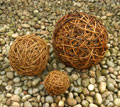
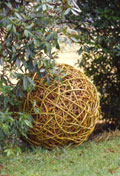
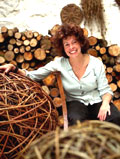
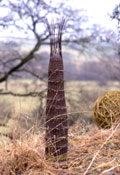

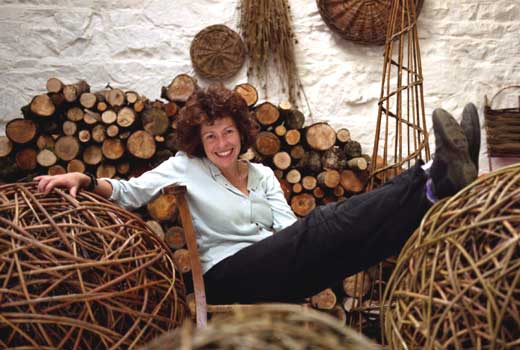
The Wicker Woman.
In the wilds of the Scottish borderlands Lizzie Farey works wonders with willow - forget baskets, and think abstract art.
**************************************
Craft, willow work, basket weaver... hardly words to set the pulse racing, associated as they are in the (possibly shallow and elitist) mind with macrame plant holders, ye olde tourist trappes and outposts of occupational therapy. Imagine then the doubt that clouded the brow of your correspondent as she boarded the 06,45 train heading north to Carlisle and thence, via ScotRail and local taxi, through fields of sheep and Belted Galloway cattle, between banks of foxglove and oxeye daisy, to a converted cowshed some 20 miles west of Dumfries to meet - for want of a better term - a basket maker.
And, oh, how one does want a better term. Once you've encountered Lizzie Farey's work - the sweetly curving abstract wall pieces, the slender obelisks, the darling nests with their freight of pussy willows soft as a spaniel's ear - then you want to call her a sculptor or an artist-maker, or something just a bit sexier. Her work is in several prestigious permanent collections, was shown at this year's Collect at the V&A, and has also been selected for next year's exhibition. In June, she was among a small group of artists summoned to dine with the Prince of Wales and his new Duchess at Holyroodhouse, "to celebrate Scottish art".
Exhibiting at Chelsea Flower Show for the first time this year, she was delighted to meet private collectors who already had several of her pieces and were keen to acquire more. She gave up making traditional baskets some time ago: "People feel compelled to put something inside them - jumpers or logs, even rubbish. I'm not saying my pieces are never functional but the material must predominate; they are not primarily vessels." Just at the moment, she can't stop making balls - big ones and small ones, huge ones that can bowl down a lane and come to rest in a grand garden where they will root and sprout and then, in winter, have the new growth tucked and woven back into the whole - a living willow sculpture.
Inside her whitewashed studio, with its old sofa, wood-burning stove and sheaves of multicoloured willow stacked against the wall ("they are my palette"), Farey rolls a ball across the work table to me. It is about 16cm in diameter, like a large ball of knitting wool; the tangle of willow stems range in colour from ochre through maroon and chestnut to nearly black, and give off the soft lustre of oiled wood. It is sensual, contemplative and slightly mysterious: despite the open weave, you cannot see to the centre. "To me it encompasses nature and tranquillity," says Farey. "If you are unfortunate enough to live in a city, you can have a willow ball and get the feeling of walking in a wood."
She herself has had little truck with cities since moving from Bath to the Borders and the stonewalled pastures of Dumfries and Galloway 20 years ago. "I like solitude," she says. Back then, she was a stained-glass artist but a chance encounter with a basket maker got her weaving. Soon she was hooked. "The technique you can leam in an afternoon," she admits, "but the feeling for the material takes years to develop." She used to import the willow from Somerset and sourced some of the more exotic forms from the shores of Loch Na Fooey in Co Galway, but now she grows all her own supplies on small plots of rented farmland and in the walled garden of a neighbouring manor house, where the owners charge Farey no rent because they like to see their soil being productive. "Willow's dead easy to grow, you just stick a little hardwood cutting in the ground and off it goes," she says. The bare stems are harvested the following January and February, when winter winds and frost are at their most bitter. "I have a gaggle of women to help me; we get dressed in waterproof trousers and boots and all our warmest clothes and get down to it." Very Thomas Hardy: the women toiling in the fields, bent double to cut the stems off at the ground, and then lugging the waterlogged sheaves over to the waiting trailer.
The little stone barn where the willow dries off is warm and delicately scented; the stems - or withies - are sorted and tied into loose bundles, some as much as 3 metres high, each a subtly different colour from its neighbour. There is ebony and russet, deep red and sage green; there is pale blue and soft purple with a bloom like a damson plum. Their names are an incantation: Flanders Red, Brittany Blue, Oxford Violet, Black Satin, Purple Osier, Green Dicks, Whissender, Dicky Meadows. To one side are bundles of twigs gleaned in the local woods - bog myrtle, birch catkins, dogwood, honeysuckle and wild plum - and ash from coppiced hedgerows, which Farey uses to augment her willow works. This is a woman in love with her materials: "I have been known to hug a bolt of willow - it's as good... well, it's just lovely." As good as a man, was she going to say? She smiles, ducks her head. "Yes I was but I didn't want to sound dippy. It smells gorgeous, too." After drying, the withies are plunged into a long water trough for 7 days to render them pliable, and then brought in to be worked.
In the corner of the studio are three figures of different heights, shaped like obelisks but curling over with feminine grace at the tips. Farey's father died in
a shocking accident two years ago and the family of five siblings mustered together, first around the intensive care bed, and then around their mother. The three figures represent Farey and her two sisters, one of them her identical twin. When the funeral was over, Farey came home to Dumfries, her heart full of grief. "I tore into my work. It all came out; I made the three figures and I made this, a eulogy for my dad" - a willow ball with a halo of white pussy willow hovering above it. Since then she has made the three figures several times on commission: "They are much in demand, though obviously they will have a different meaning for different people."
**************************************
'If you have the misfortune to live in a city, you can have a willow ball and get the feeling of walking in a wood'
See Lizzie's work at Chelsea Crafts Fair, October 2005.